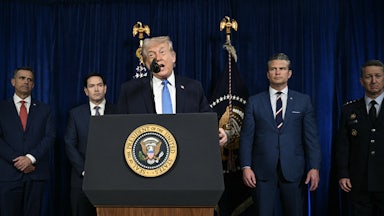No Labels, a well-funded centrist group in Washington, D.C., describes itself as “an organization of Democrats, Republicans, and independents working to bring American leaders together to solve problems.” The group seems to want to create one instead during next year’s presidential election.
Third Way, a Democratic-aligned nonprofit group, charged No Labels on Tuesday with orchestrating a “radical new plan” to block President Joe Biden from getting a majority in the Electoral College. The plan consists of running a well-funded third-party candidate in key states, then sending the election to the Republican-controlled House of Representatives, where former President Donald Trump would be virtually certain to win.
“No Labels has made clear that their new plan is to put a Republican at the top of their ticket,” Third Way claimed in a memo published on Tuesday. “And because they can’t win the presidency outright, they’ve indicated that their intention now is to exercise leverage over the winner by denying both major parties 270 Electoral College votes. That radical new plan would ensure a second Trump term.”
Such an outcome would be a disaster for American democracy. Trump may very well win the 2024 presidential election on his own if Biden’s support continues to weaken, which would be dangerous in and of itself. But a contingent election in the House of Representatives would compound the problem by sidestepping the will of the American electorate entirely in favor of a two-century-old mechanism that has destabilized the country before.
No Labels has previously denied that this is what it hopes to achieve, in an undated FAQ on its website. “No Labels is solely getting ballot access,” it claimed. “That’s it. We will not run a presidential campaign. No Labels will not offer our ballot line to an independent Unity ticket unless it has a chance to win outright in the Electoral College.” (An “independent Unity ticket” has no chance to win outright in the Electoral College.)
But Third Way pointed to more recent statements by No Labels employees and some of their published materials. Ryan Clancy, No Labels’ chief strategist, said in a CNN interview in May that No Labels could use its electoral votes as a “bargaining chip” with one of the two major-party candidates to prevent a contingent election. Since Trump would almost certainly win a contingent election and would have no incentive to avoid one, that would mean “negotiating” with Biden.
And in an explainer published on RealClearPolitics in August, No Labels highlighted a contingent election as one potential pathway to “win” a presidential election, recounting past instances where a small faction was able to tip the outcome. “Political scientists debate what would happen in such a contingent election in modern times, but 1824 shows that the path to the Oval Office can be more unlikely than voters often imagine,” it coyly concluded.
Third-party candidates are invariably hopeless in American politics. They lack the public support or political infrastructure to mount serious bids for the presidency. The most potent recent attempt came in 1992, when Texas businessman Ross Perot funded a viable challenge to GOP incumbent George H.W. Bush and his Democratic challenger, Bill Clinton. But Perot still failed to get a plurality of voters in any single state, something that no third party has done since 1968. Since the 2000 presidential election, third-party bids are often seen as spoilers that could tip a narrow election.
That appears to be No Labels’ goal. Most of its public-facing materials emphasize that it wants to obtain ballot access in all 50 states and the District of Columbia. But other polling documents emphasize that the group’s most viable path for success comes from running a Republican candidate like former Maryland Governor Larry Hogan in states where Biden won in 2020 by the thinnest of margins, like Arizona, Nevada, Michigan, Wisconsin, and Georgia. In those circumstances, its polling shows that Trump gains a slight edge as Hogan (or another No Labels candidate) draws disaffected anti-Trump Republicans away from Biden.
This strategy relies on exploiting a flaw in the American constitutional order. In most presidential elections, whoever wins the popular vote also wins 270 electoral votes in the Electoral College. That usually makes choosing a president fairly straightforward. The Electoral College also makes it possible for a candidate to win at least 270 electoral votes without the popular vote. Donald Trump was the most recent candidate to achieve this, in 2016, which was the fifth time in American history that it had happened.
But what happens if no candidate wins 270 electoral votes? Almost all American elections simply award the office in question—a Senate seat, a governorship, and so on—to whoever receives a plurality of votes. But presidential elections have a backup mechanism instead. If no candidate receives a majority of the total number of electoral votes, the Electoral College becomes deadlocked and can’t choose a winner. The Constitution then requires the House of Representatives to elect a new president and the Senate to elect a new vice president, in what are known as contingent elections.
This format has a unique method of balloting: Instead of House members casting individual votes, each state receives a single vote and the members from each state vote on the candidate for whom it should be cast. Wyoming’s single representative would likely cast one vote for a Republican candidate, for example, while California’s 53-member delegation would likely cast one vote for a Democratic candidate. Partisan gerrymandering in red states and other basic facts of American political geography mean that Republicans control a majority of House state delegations.
While contingent elections have happened three times in American history, there hasn’t been one for almost two hundred years. The first time was in the second-ever presidential election in 1800. The House ultimately elected Thomas Jefferson after 35 ballots over a six-day period in 1801. Since the vote was complicated by the fact that whoever received the second-most votes would become vice president, Congress and the states passed the Twelfth Amendment to set up separate ballots for president and vice president.
The second instance is more infamous. In the 1824 presidential election, a presidential candidate needed 131 electoral votes to win outright. The states ultimately gave electoral votes to four candidates: John Quincy Adams, Andrew Jackson, Henry Clay, and William Crawford. Jackson received a plurality of electoral votes and popular votes. But Clay threw his support behind Adams, and their combined blocs of states gave Adams a majority over Jackson.
That maneuver destabilized the politics of the early republic. Jackson’s many supporters denounced Clay’s move as a “corrupt bargain,” especially after Adams selected Clay to serve as his secretary of state. The Democratic-Republican Party fractured, with Jacksonians forming what would become the modern Democratic Party. Their victory in the 1828 election set the stage for what would become the two-party system, as well as the sectional and partisan strife that would lead to the Civil War.
The last instance is also the most instructive. In 1836, Jackson declined to run for a third term and anointed Martin Van Buren as his successor. Van Buren handily won both the popular vote and the electoral vote. But his running mate, Richard Mentor Johnson, did not. Virginia delegates, acting as faithless electors, declined to vote for Johnson to become vice president because of his widely reported relationship and common-law marriage with an enslaved woman.
With no vice presidential candidate receiving a majority of electors, the Senate had to elect one instead. They overwhelmingly chose Johnson. Though Johnson ultimately prevailed, his contingent election showed how one faction could tilt a narrow presidential or vice presidential election away from the Electoral College, where Democrats have at least some pathway to victory, into the hands of a gerrymandered House of Representatives.
No Labels, for its part, has often claimed it would only run a candidate in 2024 if they had a viable pathway to win 270 electoral votes. Since that is virtually impossible in modern American politics, however, their plan would instead funnel wealthy donors’ funds into a kamikaze campaign that could only make it harder for one party’s candidate to win the White House.
Trump’s election in 2016 was already destabilizing enough after he failed to win a majority of the popular vote, leaving him with all the power and no democratic mandate or legitimacy to support it. His defeat and subsequent coup attempt in 2020 ended the nation’s two-century tradition of peaceful transfers of power. If Trump recaptures the White House because No Labels cleared a path for him to win even without a majority in the Electoral College, why would anyone have faith in this country’s democratic systems ever again?










